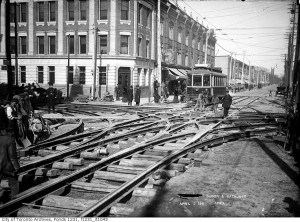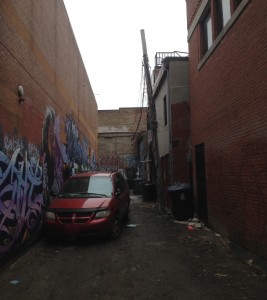The Chinese in Early 20th Century Toronto: Back of 801 Bathurst Street – Chong Sing’s Laundry
Shop researched by: Phoenix Simms
According to Valerie Mah’s thesis, “The ‘Bachelor’ Society,” Chong Sing and 1 other Chinese person lived at 807 Bathurst Street around 1900. As it turns out, after digging through the assessment rolls for 1900-1902, Chong Sing was found to actually live in the back of lot 556 on Bathurst Street, also listed as “801- back.” For the first assessment roll that Chong Sing is listed (1899 prepared for tax year 1900), there is also a clerical error regarding his name. On this roll he is recorded as “Chong Chong” (Reel 143) but all the other information lines up with the Toronto City Directories for the same years. 801 Bathurst is not listed in 1899 of the city directories (Reel 44). All subsequent assessment rolls (Reels 143, 149, and 156) list his name properly.
On the Toronto City Directories microfilm reels for 1899 to 1902 Chong Sing is listed as living at 801 Bathurst and his business is a laundry. Lot 556 or 801-back and several lots heading up on the same side of the street were owned by “Land Security Company” (Reels 143, 149, and 156). It was difficult to determine whether there was another Chinese person living at the address with Chong Sing as the assessment rolls only listed his name as a tenant. There were no other notes indicating that there was another Chinese person living there, but since lot 556, also known as 801 Bathurst, was a split lot, with Chong Sing living in the back of the lot, it is possible that whoever lived in the other half of the lot was another Chinese tenant. It is not likely though, since the front of 556 was probably where the owner of the other lots on that street lived.
Chong Sing appears to have been a Chinese bachelor, judging from his age — 26 years old — in the assessment roll for 1900, coinciding with the year he first was recorded in the Toronto Street Directories, 1900. His education is listed as “P” (Reels 143, 149, and 156), but according to the archivist he might have been listed as such because the owner of his building had public education and listed all tenants in his lots as having public education. Mah’s thesis states that “During the late nineteenth century agents from Hong Kong went from village to village in South China to recruit laborers for shipment from Hong Kong to Canada and other countries. They left for speculation as well as the fact that the land had been left devastated after the Tai Ping Revolution” (3). 1900, the year Chong Sing is first listed in the Toronto city directories was also the height of the Boxer Revolution and it is possible that that was another factor in Chong Sing’s migration to Canada (Harry Con et al, 75). A third possible reason for Chong Sing’s migration was that he was a sojourner Chinese immigrant who was to work in Canada until he gained enough income to go back to China and bring back a son or nephew. This was apparently more common after 1900 (5). At that time, China’s daily wages were only seven cents a day, so the prospect of working for a dollar a day in Canada was another big pull for bachelors like Chong Sing to immigrate to Canada during the turbulent late nineteenth century to early twentieth century period (5).
The laundry Chong Sing ran appears to have been successful, as assessment rolls 1900 and 1902 show his taxable income as $800 and $600, respectively. This is quite significant, as Mah describes that these early laundries needed “$500-600 and/or up to $2,000 capital…Financing could be done through the credit system of the Tong” (23). This means Chong Sing was able to make back what he owed to start his business, plus $200 dollars over that amount within his first year of opening his laundry!
Here are a few facts that will illustrate a little of what running a laundry was like during the exclusion era of Canada. All clothes were washed by hand using a washing machine that was essentially “a huge cylinder made of wood and later metal. It had a forward and backward rolling motion like two huge cylinders, one within the other” (23). The process of using this machine was complex and the laundrymen hung all the washing on drying lines inside on each side of the room (23). They washed everything: from clothes to sheets to curtains, but since laundries made small capital, they left the linens for big hotels to take care of (24). The hours for a laundry were typically “twelve hours a day and often on Sunday” (25), although it is cited in Mah’s thesis that families would take Sundays off sometimes to go to Church where it was possible to learn English (25). A popular pastime of the sojourner bachelors of Chinatowns in this period was gambling. Gambling offered a chance to socialize with one’s community, but also for the opportunity to gain a bit more money, especially for those men who are homeless. “The men [would] gather in tiny parlours hidden behind laundries, shops or restaurants or in rooms below the level of the street” to play pan tan, pai kop piu, gee fah or mah jong (61).
Today, the back of 801 Bathurst is just an alleyway between a CIBC and wholesale textiles shop. It was difficult to find any photos of the exact address from the era Chong Sing immigrated to Canada, but to give an idea of what the intersection Chong Sing lived near (Bathurst and Bloor Street West) looked like, take a look at the black and white photo attached to this article.
Works Cited:
Assessment Roll: Ward 4 Division 3 1900 (1899 for tax year 1900), Reel 143
Assessment Roll: Ward 4 Division 3 1901 (1900 for tax year 1901), Reel 149
Assessment Roll: Ward 4 Division 3 1902 (1901 for tax year 1902), Reel 156
Con, Harry et al. From China to Canada: A History of the Chinese Communities in Canada. Toronto: Mclelland and Stewert Ltd., 1982. Print.
Mah, Valerie. The bachelor society: a look at Toronto’s early Chinese community from 1878-1924. MA Thesis. 1978. Print.
Bloor and Bathurst Sts., track laying. April 3, 1911. City of Toronto Archives, Toronto. Print.
Toronto: Might’s Directory Co. 1899. Microform. the Toronto city directory for 1899. Location 264730-44, Reel 44.
Toronto: Might’s Directory Co. 1899. Microform. the Toronto city directory for 1900: Vol. XXV. Location no. 2643730-45, Reel 45.
Toronto: Might’s Directory Co. 1901. Microform. the Toronto city directory for 1901: Vol. XVII. Location no. 2643730-47, Reel 47.
Toronto: Might’s Directory Co. 1902. Microform. the Toronto city directory for 1902: Vol. XXVII.
Location no. 2643730-48, Reel 48.


